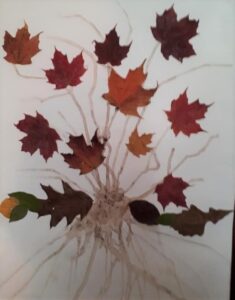WHEAT Institute provides top quality training in the therapeutic use of the arts

By Rick Garrick
WIIKWEMKOONG UNCEDED TERRITORY — Two Wiikwemkoong Unceded Territory citizens are enjoying the Winnipeg Holistic Expressive Arts Therapy (WHEAT) Institute’s Indigenized Expressive Arts Therapy Certificate program, one as a student and the other as a course instructor. Dorothy Wassegijig-Kennedy enrolled in the program this past fall and Rhonda Hopkins teaches the Storytelling course.
“It was being offered online and it really resonated with me,” Wassegijig-Kennedy says. “I saw an ad on Facebook advertising an Indigenized Arts Therapy certification course. At that time, I felt I needed something spiritual and with some connection to the Earth and nature. I was introduced to a really different way of being and seeing. It was refreshing and healing but at the same time very structured.”
Wassegijig-Kennedy, who retired from her community wellness worker position last year, says the courses have been “very enlightening and expanding” on her knowledge of many years of working in the healing and wellness field.
“I was able to connect with a spiritual element in myself, and Mother Earth’s gifts,” Wassegijig-Kennedy says. “I have enhanced my own personal development such as boundary strengthening, arts in social action and uploading new approaches I can use in the helping field.”
Hopkins, Anishinaabemowin immersion specialist at Kenjgewin Teg, says her goal is to encourage creativity to take place during the Storytelling course.
“So I don’t necessarily instruct in storytelling because I search and bring out the storyteller in each of the students,” Hopkins says. “However, I have shared storytelling and one of the things we have done is our mnemonic device, which was an assignment where I created a mnemonic device that would help recite a story, an event or an activity that a student had participated in. So they’re telling me stories using this mnemonic device that they’ve created.”
Hopkins says the Storytelling course runs for 10 weeks with one-hour classes once a week.
“I’m really enjoying the course myself,” Hopkins says. “The students are very intrigued by the presentation.”
Darci Adam, director at the WHEAT Institute, says the goal of the program is for the students to learn about the therapeutic use of the arts from an Indigenous worldview perspective.
“All of the teachers teaching in our Indigenized program are Indigenous and we have a compulsory Indigenous language component that includes language as well as storytelling,” Adam says. “Our hope is that people will be learning about the Indigenous world views and also the ways that the arts have traditionally been used for healing and wellness and as a spiritual connector and really just deepen their experience of Indigenous cultures and healing through the arts.”
Linda Manitowabi, WHEAT Grandmother’s Advisory Council member and Wiikwemkoong citizen, states in a WHEAT blog posting that she saw the need for educating and giving Indigenous people the tools to help healing happen in their communities after working on a project with WHEAT in northwestern Ontario.
“I saw Art Therapy as a safe, yet powerful tool to begin the healing journey through our stories with ceremony, with song and our language to help them understand who they are and where they come from,” Manitowabi states. “The Elders have taught me that if we want to heal our people, we need to do it ourselves and in our own ways. And for this reason, I sat with the Grandmothers to begin to visualize an Indigenous Art Therapy program to educate not only our people but also the non-Indigenous people who work in our communities to begin the art of healing, our way.”
Information about the WHEAT Institute, which was incorporated in 2014, is posted online.


